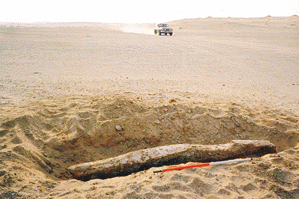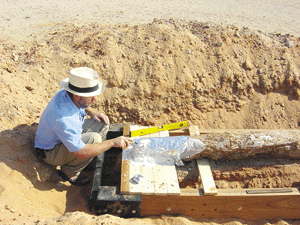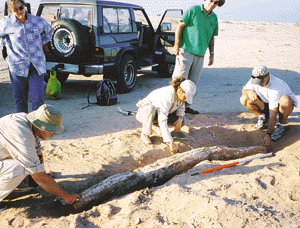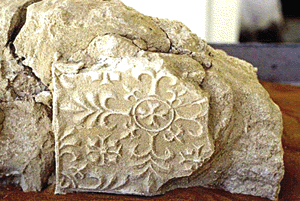| Source: Oman Observer - 18 Oct 2003
|
| When Rivers ran through
Ancient Arabia |
| IMAGINE a time
six to eight million years ago when what is now the Arabian peninsula
was a verdant place where rivers flowed and giant prehistoric animals
flourished. Among these animals was an ancestor of the elephant —
a mammoth creature with four tusks. And in the desert sands of present
day Abu Dhabi, Dr Mark Beech found a tusk from one of these ancient
animals.
The tusk was 2.5 metres in length. What an incredibly exciting find! And this was only the beginning. Before too long, equally old fossil fragments of ancestors of crocodiles, probable hippopotamus, giant turtles and primitive horses were discovered, again in the desert sands. By Patricia Groves The picture that emerges of life six to eight million years ago in the late Miocene period is of a thickly vegetated land, abounding in wildlife, not unlike present day East Africa. There was evidence of wide rivers flowing through what must have been well-wooded savannah plains. This series of finds is what Dr Beech calls a “Golden Great” of Palaeontology, the scientific study of life existing in former geological periods. Dr Mark Beech is a research fellow from the University of York working as the Senior Resident Archaeologist on the Abu Dhabi Islands Archaeological Survey (ADIAS). Shaikh Zayed bin Sultan Al Nahyan, the president of the UAE, established ADIAS eleven years ago, and the organisation is charged, under the patronage of Shaikh Mohammed bin Zayed Al Nahyan, with surveying for, recording, and, where appropriate, excavating archaeological sites on the coast and islands of Abu Dhabi. Dr Beech described the process by which the fragile elephant tusk was safely taken from its almost unfathomably old bed in the sand. |
  Just under the surface of the sand Dr Mark Beech found a 6-8 million-year-old tusk from an ancestor of the elephant (Stegotetrabelodon syrticus), a mammoth creature with four tusks. This enormous tusk, 2.5 metres long, might have shattered into thousands of fragments if not injected with “reversible” glue, wrapped in protective covering and lifted by crane in the purpose-built case shown above. |
First, the tusk, which might have shattered into thousands of fragments if disturbed, was treated with a “reversible” glue to hold it together. Then, while still in its bed of sand, the tusk was encased in a protective layer of foam. An open wooden case was constructed and carefully inserted under the tusk to contain both the tusk and the bed of sand. The case, weighing about 400 kg, was then lifted by
crane onto a truck, which would carry it over the rough desert terrain
seven kilometres to the nearest tarmac road and on to the ADIAS
headquarters in Abu Dhabi. There the tusk would be removed from
the case, the foam taken off, the glue “reversed” with chemical
treatment; and, the tusk returned to its original state as found
in the desert. Other fossil fragments from the exotic “pre-elephant”
(Stegotetrabelodon syrticus) were discovered, including another
tusk; a relatively complete pair of jaws over one metre long; a
number of rib sections including one almost entire specimen about
a metre long — and not all from the same animal. The fragments bore
signs of being washed by a river, confirmed by palaeoecological
information. |
 Initial excavation of the first fossil found — a 2.5 metre long tusk from an ancient ancestor of the elephant |
A freshwater shell fossil was found resting
against one of the ribs along with river gravel. A fragment from a
giant turtle carapace bore the marks of crocodile teeth. From this
one small fragment, a scene emerges with a live story — the ferocious
snap of a crocodile jaw, teeth penetrating the great shell of the
turtle….
Equally evocative were the mysterious frozen tracks of unknown animals — not camels, not gazelles; were they ancestors of lions? We were shown extraordinary footprints from groups of animals going off into the distance; and then the enormous circular pad-like prints of either a colossal pre-elephant or one of lesser weight moving faster. Hundreds and hundreds of fossils footprints were found embedded in rock. Dr Beech mentions that within Palaeontology the study of footprints is a science of its own. |
The investigative aspect of Palaeontology, so vividly articulated by Dr Beech, was obviously very exciting to the audience; and, it would be safe to guess that, at this point, more than one of us would have volunteered to help on his next expedition. This was part one of Dr Beech’s presentation, set many millions of years ago in the late Miocene period. He then moved on to a time in the history of the Arabian peninsula only seven thousand years ago during the Arabian Neolithic period when the inhabitants were not just hunting and fishing, but also herding domesticated animals, including goats and sheep. The evidence allowed a remarkable glimpse into this pastoral community, showing that a broad economic base supported what appears to be a relatively comfortable lifestyle. Excavations on the islands and shores of Abu Dhabi revealed findings very similar to those discovered in Oman, where remains indicated that people lived in circular structures, wore beautifully designed shell jewellery and used flint tools. On Dalma Island in the UAE, Dr Beech found sherds of plaster vessels made from local gypsum, and traces of other household goods. Ubaid pottery sherds with distinctive black stripe decoration indicated the existence of trading links with Mesopotamia. The pottery was made in what is now southern Iraq near Tell Al Ubaid. The ancient settlement on Dalma also provided some of the earliest evidence for date consumption in the Arabian peninsula. Dr Beech ended his lecture on the ADIAS project by again zooming forward in time, bringing us to a period only 1,500 years ago on Sir Bani Yas Island. Here the remnants of a pre-Islamic church and monastery were unearthed. |
| ADIAS archaeologists found panels like
tiles, made of plaster, with the appearance of having been carved
in stone. Some of the panels depicted crosses; others bore different
early Christian representations, such as grape clusters.
The site represents the first archaeological evidence of Christianity in the United Arab Emirates, and indeed in southeastern Arabia. A very similar church was discovered by French archaeologists in the 1980s working on the island of Failaka in Kuwait. The majority of the pre-Islamic Christians in the area were from the Church of the East, formerly known as Nestorian Christians. The site on Sir Bani Yas Island was abandoned in the mid to late seventh century AD. Christianity rapidly disappeared after the coming of Islam, probably as a result of conversion or dispersal. |
 At the Sir Bani Yas Island site ADIAS archaeologists found panels like tiles, made of plaster, with the appearance of having been carved in stone |
| In a short space of an hour, we were taken
across immense periods in time, from the later Miocene period several
millions of years ago, to a relatively recent era approximately 7,000
years ago and finally to the immediate pre-Islamic era. At each of
these “stops” in time, significant new information was revealed, expanding
our picture of the past. It was naturally the most exotic reference
— to the furthest point in the past which ignited the imagination
most.
It is a persistent human characteristic to wonder about the past and to try to solve its mysteries. Even space investigations are geared as much to understanding the origins of the universe, our galaxy and solar system, as they are to anticipating the future. Perhaps the more we know about the past, the more firmly rooted we feel here and now. Whatever the reason, having concrete information about an era almost unimaginably long ago when rivers ran through Arabia is both exciting and strangely comforting. |
| Windows that Open to the
Past An interview with Dr Mark Beech, the Archaeologist who discovered evidence of rivers running through ancient Arabia six to eight million years ago By Aruna Shaji |
| THE invaluable
knowledge offered by archaeologists comes as an oasis in a desert
where mankind thirsts for knowledge of its past. Awe-inspiring questions
about past human culture and the changes that have taken place in
human societies through centuries fill the minds of people from all
walks of life regardless of nationality, religion or continent. Archaeologists
look for information about how, where and when cultures developed.
Archaeological evidence unearthed and identified are vital windows
to the past!
The dramatic landscape of the Sultanate of Oman has long been enticing archaeologists who have not been very successful resisting their itch to bring Oman, long known as the hermit of the Middle East, out from its shell. Dr Mark Beech, senior resident archaeologist for the Abu Dhabi Islands Archaeological Survey (ADIAS), was in Muscat recently on invitation by the Historical Association of Oman. Dr Beech, who has more than 20 years of field experience working on a range of impressive historic and archaeological sites and projects gave a lecture about his exciting findings in the past 10 years in the UAE. |
 Dr Mark Beech |
| Dr Mark Beech, is also an Honorary Visiting
Fellow, at the Department of Archaeology, University of York, in the
UK. Talking to Observer,Dr Beech said, archaeology gives a deeper
appreciation of humanity and a country could have a future only if
it can appreciate its past. About Oman, Dr Beech says there are lots
of similarities in the prehistory and history of the present day UAE
and Oman because in the past, there were no national boundaries between
the two countries. “This is my first chance to visit this very large
country which is uniquely rich in archaeology”, he said.
“The similarities in the archaeological sites explain how people moved about in the combined areas. The history and archaeology of both the countries are intermingled. Behind all the present modernisation and industrialisation, Oman is strewn with precious archaeological finds that speak for themselves. Surveys reveal a large number of Pre-Islamic cemeteries and settlements that provide archaeologists with interesting information about how people lived thousands of years ago,” he says. The Abu Dhabi Islands Archaeological Survey was established in 1992 by President Shaikh Zayed bin Sultan al Nahyan. ADIAS is charged under the patronage of Shaikh Mohammed bin Zayed al Nahyan, with surveying for, recording and where appropriate, excavating archaeological sites on the coast and islands of Abu Dhabi. In the more than twelve years that have followed, ADIAS has identified over a thousand sites or groups of sites on the coast and islands of Abu Dhabi. “My trip now was also intended to collect and exchange more information, archaeological publications and other details that would help guide us in our work here. On this visit I have been meeting with research colleagues at the Ministry of National Heritage and Culture, the Department of Archaeology at the Sultan Qaboos University and the Bait Al Zubair Museum, discussing the future, and possible collaborative projects. “It is important for archaeologists working in an area to communicate with neighbouring states. The main thing is that we are all fighting for the same cause, to protect the cultural heritage of a land. It is a good idea that there are centres here in Oman that invite people interested in archaeology to come forward and contribute information. Oman is blessed with an extraordinary number of archaeological sites and therefore needs a large number of trained experts to care for its rich heritage”. Dr Beech says archaeology museums in any country are very important as they provide a direct window into the past. Organising school visits to museums are important not only from the point of view of education but also because they provide a vital foundation for understanding the culture of a land and its people. Archaeology is the scientific study of the remains of past human cultures. “It is important to present how archaeological sites and their remains look at the present day. Reconstructions play an important role but they have to be done very carefully. People should be encouraged to recognise what archaeological sites look like so that they know what should be reported to the authorities. So the first problem is increasing public awareness of what is an archaeological site. The information has to be centralised and managed in an organised way. “Taking into account the number of wilayats in a big country like Oman, things could be done more quickly with one archaeologist in each wilayat to patrol and report about the archaeological sites. This, and the sufficient arrangements and the appropriate people to support, the work would be the ideal situation. In Oman there is an urgent need for a greater investment in the infrastructure of archaeology and heritage management, especially as modern developments are taking place in the country.” Dr Beech recently met some young Omani archaeologists who have graduated from SQU “The future appears bright for Oman with the younger generation very passionate about protecting their heritage. There are more people being trained in archaeology today. I met some of them in London and the UAE at conferences. Many have done their Master’s degrees in the UK and USA.” Dr Beech, who grew up in England says he decided to be an archaeologist right from the age of 8 or 9 when he used to insist his parents take him to museums and archaeological sites. At a very early age he joined the Young Archaeologist’s Club in England and later, went on to complete his Bachelor’s degree from the Institute of Archaeology at the University of London which was established by Mortimer Wheeler, the famous archaeologist who excavated Mohenjo-Daro and Harappa. He took his Master’s degree, specialising in environmental archaeology, at the Department of Archaeology and Prehistory at the University of Sheffield. He was particularly interested in the link between humans and their environment. His research interest was centred in the prehistoric period. The Neolithic period, from about 7,000 to 5,000 years ago, was of particular interest to him. Dr Beech says this time period fascinated him because it is when the earliest known settlements appear in the UAE. Some of the pottery that has been unearthed has been found to originate from southern Iraq. So it shows that 7,000 years ago people made use of sophisticated boats for the purpose of trade and transportation. Dr Beech has had the opportunity to work in a number of other countries like Jordan together with a team from the British Museum. He has also worked in Pakistan on two expeditions. More recently he has spent time in Kuwait and Bahrain visiting important archaeological sites. “The world is much smaller today than it was before,” says Dr Beech. “We have very fast communication and travel to different parts of the world. Hence, it is more important today than ever before that we appreciate each others’ culture and live in harmony. Archaeology takes you on a journey and
connects you into the past and to the present, exchanging ideas.
None of us come from nothing and each of us have an interesting
journey to complete. Archaeologists are mainly interested in what
we call cultural transmission, the transfer of cultural practices
and ideas between different past communities. We should enjoy the
diversity of cultural expressions witnessed through archaeology
and learn from the heritage of our ancestors!” |